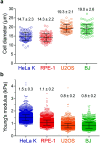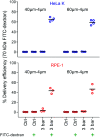Efficient and gentle delivery of molecules into cells with different elasticity via Progressive Mechanoporation
- PMID: 33977944
- PMCID: PMC8204113
- DOI: 10.1039/d0lc01224f
Efficient and gentle delivery of molecules into cells with different elasticity via Progressive Mechanoporation
Abstract
Intracellular delivery of cargo molecules such as membrane-impermeable proteins or drugs is crucial for cell treatment in biological and medical applications. Recently, microfluidic mechanoporation techniques have enabled transfection of previously inaccessible cells. These techniques create transient pores in the cell membrane by shear-induced or constriction contact-based rapid cell deformation. However, cells deform and recover differently from a given extent of shear stress or compression and it is unclear how the underlying mechanical properties affect the delivery efficiency of molecules into cells. In this study, we identify cell elasticity as a key mechanical determinant of delivery efficiency leading to the development of "progressive mechanoporation" (PM), a novel mechanoporation method that improves delivery efficiency into cells of different elasticity. PM is based on a multistage cell deformation, through a combination of hydrodynamic forces that pre-deform cells followed by their contact-based compression inside a PDMS-based device controlled by a pressure-based microfluidic controller. PM allows processing of small sample volumes (about 20 μL) with high-throughput (>10 000 cells per s), while controlling both operating pressure and flow rate for a reliable and reproducible cell treatment. We find that uptake of molecules of different sizes is correlated with cell elasticity whereby delivery efficiency of small and big molecules is favoured in more compliant and stiffer cells, respectively. A possible explanation for this opposite trend is a different size, number and lifetime of opened pores. Our data demonstrates that PM reliably and reproducibly delivers impermeable cargo of the size of small molecule inhibitors such as 4 kDa FITC-dextran with >90% efficiency into cells of different mechanical properties without affecting their viability and proliferation rates. Importantly, also much larger cargos such as a >190 kDa Cas9 protein-sgRNA complex are efficiently delivered high-lighting the biological, biomedical and clinical applicability of our findings.
Conflict of interest statement
The authors declare that they have no competing interests. TU Dresden and MPG has filed a patent application based on this work, in which S. G, R. G., A. U., J. M. and J. G. are listed as inventors.
Figures






Similar articles
-
Microfluidic Mechanoporation: Current Progress and Applications in Stem Cells.Biosensors (Basel). 2024 May 17;14(5):256. doi: 10.3390/bios14050256. Biosensors (Basel). 2024. PMID: 38785730 Free PMC article. Review.
-
HiViPore: a highly viable in-flow compression for a one-step cell mechanoporation in microfluidics to induce a free delivery of nano- macro-cargoes.J Nanobiotechnology. 2024 Jul 27;22(1):441. doi: 10.1186/s12951-024-02730-y. J Nanobiotechnology. 2024. PMID: 39068464 Free PMC article.
-
Microfluidic mechanoporation for cellular delivery and analysis.Mater Today Bio. 2021 Dec 20;13:100193. doi: 10.1016/j.mtbio.2021.100193. eCollection 2022 Jan. Mater Today Bio. 2021. PMID: 35005598 Free PMC article. Review.
-
Enhanced intracellular delivery via coordinated acoustically driven shear mechanoporation and electrophoretic insertion.Sci Rep. 2018 Feb 27;8(1):3727. doi: 10.1038/s41598-018-22042-0. Sci Rep. 2018. PMID: 29487375 Free PMC article.
-
Massively-Parallelized, Deterministic Mechanoporation for Intracellular Delivery.Nano Lett. 2020 Feb 12;20(2):860-867. doi: 10.1021/acs.nanolett.9b03175. Epub 2019 Oct 28. Nano Lett. 2020. PMID: 31647675 Free PMC article.
Cited by
-
Laser-Induced Intracellular Delivery: Exploiting Gold-Coated Spiky Polymeric Nanoparticles and Gold Nanorods under Near-Infrared Pulses for Single-Cell Nano-Photon-Poration.Micromachines (Basel). 2024 Jan 23;15(2):168. doi: 10.3390/mi15020168. Micromachines (Basel). 2024. PMID: 38398898 Free PMC article.
-
Sonoporation: Past, Present, and Future.Adv Mater Technol. 2022 Jan;7(1):2100885. doi: 10.1002/admt.202100885. Epub 2021 Sep 14. Adv Mater Technol. 2022. PMID: 35399914 Free PMC article.
-
Engineering a Microfluidic Platform to Cryopreserve Stem Cells: A DMSO-Free Sustainable Approach.Adv Healthc Mater. 2024 Nov;13(29):e2401264. doi: 10.1002/adhm.202401264. Epub 2024 Aug 17. Adv Healthc Mater. 2024. PMID: 39152923 Free PMC article.
-
High throughput intracellular delivery by viscoelastic mechanoporation.Nat Commun. 2024 Jan 2;15(1):115. doi: 10.1038/s41467-023-44447-w. Nat Commun. 2024. PMID: 38167490 Free PMC article.
-
Delivering the CRISPR/Cas9 system for engineering gene therapies: Recent cargo and delivery approaches for clinical translation.Front Bioeng Biotechnol. 2022 Sep 26;10:973326. doi: 10.3389/fbioe.2022.973326. eCollection 2022. Front Bioeng Biotechnol. 2022. PMID: 36225598 Free PMC article. Review.
References
Publication types
MeSH terms
LinkOut - more resources
Full Text Sources
Other Literature Sources

